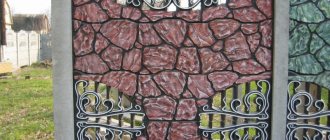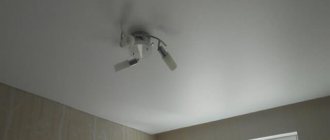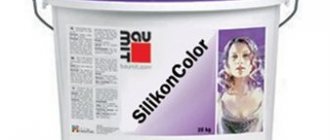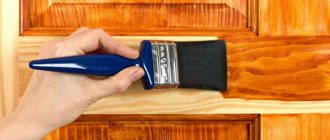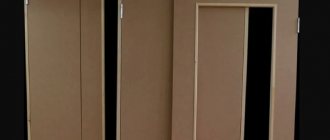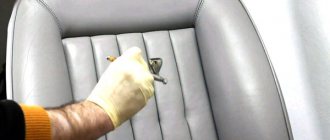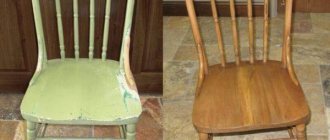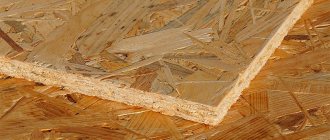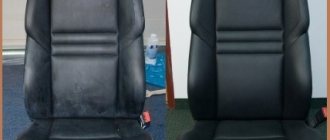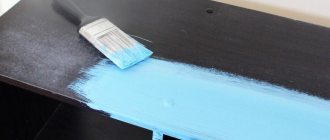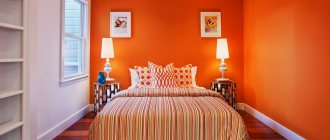Painting plywood is considered a necessary measure to protect the material from excessive moisture or other harmful environmental influences.
Currently, plywood is still often used in construction, especially private construction. It is made from thin sheets of veneer, which are glued together with adhesives of various compositions. It is used for the production of furniture, wall coverings, floors, as well as finishing the facades of buildings.
Why is plywood so popular? Durability and environmental friendliness are the main advantages of this type of building materials.
But it’s not enough to just purchase plywood and use it in its pure form for your needs. It is necessary to apply a number of measures thanks to which the plywood board can last a long time. And one of these measures is painting.
Let's look at each stage of painting plywood in more detail.
Water-based acrylic paint
If the building material will be installed in a residential building (apartment), then you can take a closer look at water-based paints, which are suitable for interior decoration.
The use of acrylic paint is widespread: it is environmentally friendly, easy to handle, quite durable, and also allows the use of a wide range of shades. The paint is applied to the plywood in two layers, and both sides and ends are treated. If there is no active mechanical impact on the sheets, then the choice can be made in favor of conventional water-based paint.
Should plywood be coated (impregnated) with drying oil before its installation, or after, which is better?
Plywood will be installed on the floors and ceiling.
Ordinary plywood is not moisture resistant.
We want to sand the plywood.
Should the plywood be impregnated with drying oil before its installation, or can it be done after, what is the correct way?
Plywood is veneer glued together.
Non-moisture-resistant plywood is covered with drying oil; in other words, non-moisture-resistant plywood is made moisture-resistant using drying oil.
Moreover, the drying oil is applied until the plywood stops absorbing it, this can be 3 or more layers with drying between layers.
If you are in a hurry, you can speed up the drying of the drying oil, for example, use a hair dryer.
The drying oil must be preheated in a water bath, the approximate temperature of the drying oil is + 50 degrees.
Heated drying oil will better saturate the plywood sheet.
Drying oil (if we are talking about interior spaces) you need something like this
When laying plywood on the floor, the sheet is unraveled (cut) into several parts, usually into 4 parts. The plywood can be laid on joists; the joists also need preliminary preparation.
It is also necessary to dry the ends of the plywood.
If we are talking about floors, then first we cut whole sheets of plywood into fragments (parts), then the plywood is installed in a vertical position and covered with drying oil.
Moreover, on both sides and + ends.
That is, it is better to dry the plywood at the beginning and only after drying the drying oil attach (mount) it to the surface.
And it doesn’t matter what surface we are talking about (ceiling, floors, walls).
If you dry only one side of a sheet of plywood, the opposite side will not be protected from moisture.
When exposed to moisture, plywood can swell and the veneer can peel off.
Moisture can also affect the end of the plywood sheet and this must be taken into account.
Source
Processing plywood before painting
Before painting, plywood must be completely cleaned of dust and small sawdust. Plywood sheets should be painted along the wood grain.
Do not forget that before preparing plywood for painting and staining, the sheet must dry thoroughly. Everyone knows the property of this material - to warp.
You can avoid the risk of deformation by simply keeping the sheets in a dry room at room temperature for 3-4 days. This is especially true if the material was stored on the street or in a damp construction warehouse. Experts recommend not neglecting this stage and keeping the material for several days in the room where you then plan to paint it.
Initially, the sheet must be sanded to remove any irregularities.
This stage can only be avoided if you purchase high-grade material. It's already quite high quality. For cheap varieties, sanding is highly desirable.
First, use coarse-grained sandpaper (No. 80-100), and then use medium-grained sandpaper (No. 100-120). This improves the subsequent adhesion of the surface to the paint. Do not forget to process the edges of the sheets; if they are too rough, they can be lightly planed and then sanded.
If you need to hide joints, fasteners or very noticeable defects, use putty. This material will also be useful to you if you decide to glue wallpaper onto plywood. Don't forget to sand the putty areas
After grinding is completed, the surface must be primed; most often, drying oil, primers with an alkyd base, or special compounds that fill the pores of the material are used for this.
For large volumes of work, it is recommended to use electric grinders. They will save time, make work easier and improve its quality.
What is a primer used for?
If finishing with plywood sheets is done indoors, then due to fluctuations in temperature and humidity, the wood texture may change: shrink and expand. The primer as an intermediate layer will not allow the applied paint to crack and will protect the base from moisture penetration and the formation of fungus. The primer is applied with a roller.
It is necessary to allow the soil to dry, and then additionally treat the plywood with antiseptics and fire retardants, which will enhance protection against fire and prevent blue stains from appearing. This is one of the important elements of the preparation process if you are going to paint plywood with transparent paint that has low resistance to bioaggressive manifestations.
Types of waterproofing impregnations
The following waterproofing options are available on the market for household needs:
- Oil-based varnishes and paints;
- Water soluble;
- Solvent based.
Modern waterproofing impregnations usually combine synthetic and natural oils, as well as organic solvents. They can be colored or colorless, in the form of varnish or paint, it all depends on the composition.
In addition to the function of insulation from water, modern protective products are also produced to protect against the biological effects of rodents, insects and fire. Water-repellent impregnations for plywood are available in liquid and gel forms.
How to paint plywood
Painting plywood correctly is not difficult. We have already talked about applying paint according to the arrangement of the fibers. You can also take a completely traditional tool: a roller, sprayer or paint brush.
Let's consider in which case it is more appropriate to choose each of these options:
Ideal for saving time and large amounts of space, such as floors, ceilings, facades;
Convenient for painting medium-sized areas, such as a plywood cabinet, for example. As for the material of the roller coat, it is better to choose foam rubber for plywood;
A universal tool that can be found in every home. Ideally paints hard-to-reach places (corners), ends and shaped elements.
Applying varnish
Sometimes varnish is used instead of paint. The plywood is first cleaned and sanded using sandpaper or a sanding machine, then it must be cleaned of any accumulated dust and degreased. Otherwise, all dirt will be visible under the varnish.
After applying the first layer of varnish, let it dry. Sand the first layer and then cover the surface with another layer. As a result of this approach, varnished plywood becomes dull.
If you want to get a glossy surface, you need to apply another layer of varnish on top. This time it is advisable to apply it using a sprayer to evenly distribute the varnish composition.
Impregnation with drying oil as an alternative method
As an alternative to impregnating paints for waterproofing wood, you can use drying oil and products based on it. This method is more expensive, but guarantees greater sophistication, and in versions containing a base of sealants, it guarantees a designer highlight of the uniform color of the plywood.
- This procedure is usually used on small pieces of wood because it is a messier method and requires better protection for the worker.
- As with varnish and paint, the plywood surface must be properly prepared by removing initial dirt and excess paint, as well as marks and chips.
- After application, drying oil will make the wood shiny and, as a result, highlight stains and defects, if any.
Drying oil should not be applied directly to the wooden surface, but to a rag, which can then be used to rub the affected part of the wood. After 30-45 minutes, you can remove the excess with a clean cloth and then let it dry completely for 24 hours.
Wood painting
To paint plywood to look like wood, you can use different shades of stain. If you need a glossy surface, apply an additional layer of varnish on top.
Plywood boards are problematic materials in terms of painting. This is due to the specific texture of the surface, which does not allow for even laying of the paint and varnish composition. Such problems arise with many wood-based materials, but painting plywood is complicated by the presence of pronounced roughness and even burrs on the outside of the board.
In the fight for moisture resistance of plywood, all methods are good!
Today, FK plywood remains the most popular building material. The range of its use is very wide. But, over time, the FC begins to darken, exfoliate and rot. The moisture resistance of plywood sheets can be increased by treating them with special impregnations. The article reveals ways to protect plywood from moisture and mold and answers the question of what to impregnate plywood with for moisture resistance.
Features of painting work with plywood sheets
Paint and varnish coatings are reluctant to apply to plywood, which is due to the uneven surface. This applies to a greater extent to materials that have undergone rough factory processing.
Therefore, preparatory activities occupy a special place in this matter. It is not recommended to apply the composition directly to a wood base, as there is a risk of getting a defective coating with obvious defects. Even if you treat the surface with a thick layer, cracks and warping of the paint will appear in the future.
Therefore, painting plywood should be done in several layers, and the base coats are not decorative. They perform the functions of priming and leveling - that is, they prepare the base for applying a full-fledged decorative layer. In some cases, special mechanical processing of the sheets is required so that the primer itself can be laid on them.
Choosing a waterproofing product
If you want a truly protective coating, purchase a product from the hardware store that is both preservative and waterproof and use it as a protective coating.
- However, whether you have applied a topcoat or not, the next step is to apply the basecoat.
- For plywood, especially if it is to be placed outdoors, it should be of the alkyd type, that is, oil-based.
- It must be distributed as evenly as possible over the dry sheet or parts. Pay special attention to ensure that the parts that will come into contact with the ground are well covered.
Now we come to the decorative layers, of which there should be two, in addition to the base layer. Don't think that adding more coats of paint will give you better protection, you're wrong.
Anyone who thinks about completely waterproofing plywood so that winter moisture does not penetrate into it is very mistaken: it will penetrate the same way, even if you put in more effort, but in the summer it will still come out, passing through a thick layer of paint, which will probably swell or crack.
Painting methods
Methods for refining plywood differ in both technical tools and the type of paint composition used.
As for tools, a regular brush, a roller, and a spray gun can be used. The highest quality results are achieved with the last tool. A pneumatic spray gun allows you to provide an even coating of paint and varnish.
In this case, the base layers can also be done with a brush - at this stage, maintaining a uniform layer is not so significant. In terms of choosing a coloring agent, everything is not so clear. If emphasis is required on aesthetic value, then, undoubtedly, preference should be given to construction paints - for example, acrylic or pentaphthalic compositions of the desired shade are suitable.
Painting plywood with varnish is also practiced, which involves a traditional set of tools - from a brush to a spatula. The treatment is carried out in several layers with long strokes. There are also special products for bleaching wood, which are also suitable for plywood.
They contain chlorine, sodium or potassium hypochlorites, lime, etc. It is advisable to use this option when working with plywood that is part of the structure of utility premises, rather than residential ones.
Preparation begins with thorough cleaning of the surface. It is necessary to remove both debris and dust, and weak damaged areas of the sheet. Next, you can grind the material. If plywood is being prepared for painting with varnish or the same acrylic paint, then this operation will be mandatory.
A machine with polishing abrasives will remove burrs, loose fragments and simply provide a smooth base. The second stage of preparation will be to create a reliable base for applying a decorative paint layer. For this purpose, primer putty on plywood for painting can be used, which contains strengthening and adhesive components. If you plan to use plywood outdoors, then it would be useful to include water- and frost-resistant additives in the primer.
Cost of work
Surely, as you already guessed, the cheapest method is to use drying oil. The cost of waterproofing depends on the surface being treated and the conditions in which it is located.
For those who do not have experience and are not familiar with homemade products, it is recommended to carry out operations with specially developed compounds, although this is more expensive.
Preparing tools and paint
In addition to the main painting tools, which must be thoroughly cleaned, auxiliary devices should be prepared. These will include the same trowel, a construction knife and equipment for supplying compressed air if you plan to use a pneumatic sprayer.
Next, the paint and varnish composition is prepared. Initially, it can be a liquid solution or a dry mixture. In both cases, thorough stirring and dilution with water is required.
It is important to consider that painting plywood will be of high quality only if the solution is uniform. It should be free of lumps and foreign bodies. If necessary, at this stage you can add modifiers to the composition that improve certain qualities of the mixture.
Preparatory work
Preparing the plywood before applying the first base coat is very important. Wood, and especially laminated wood products, is a material that expands and contracts, and waterproofing must take these movements into account.
Sun and winter cold, especially outdoors, greatly contribute to drying and shrinkage.
First of all, you should always keep in mind that water-repellent impregnation, varnish or paint adheres more firmly to a porous surface than to a smooth one, so if necessary, a thorough rubbing with 100-grit sandpaper will help prepare the plywood for good adhesion.
Instructions for applying the composition
If the choice falls on a brush or roller, then the actions should be performed smoothly and without jerking. It is recommended to cover as large an area as possible in one pass, which will minimize smudges and make the coating uniform. At the same time, it is better not to limit yourself to one layer - on average, this design is performed in 2-3 passes.
If you are preparing to paint a plywood floor, you should count on 5-6 layers, since this coating will require increased mechanical resistance. The easiest way to work is with a spray gun. It sprays the composition evenly over the entire area and the user can only monitor the abundance of coverage. In this case, leaks are also possible, but this effect can be avoided if you perform intensive movements of the working head of the tool.
Replacement of drying oil
When performing high-quality decorative work, it is difficult to replace drying oil with anything, but if we are talking about rough work, then for these purposes you can use the folk recipe for casein impregnation. By the way, the coating looks decent and dries quickly.
- Casein – 20 parts;
- Soap solution – 3 parts;
- Slaked lime – 10 parts;
- Turpentine – 7 parts.
During preparation, casein, soap solution and slaked lime are first mixed, then turpentine is added. At the finish we get a composition visually similar to drying oil. If the sediment “bounces off”, then you need to add a little ammonia.
Recommendations as you work
When working with a roller, it is important to monitor its pile. Fur models of this tool leave hairs that will be difficult to remove in the future without disturbing the structure of the coating. Therefore, initially it is better to use a foam roller.
If you plan to work with a heterogeneous structure that has complex areas and large flat areas, then it is advisable to combine tools. For example, painting plywood with a brush will be the optimal solution for working with corners, edges and curved elements. It is better to process a large, flat surface with a pneumatic tool. The direction of the tool at the time of movement should be longitudinal relative to the wood fibers - such a scheme for applying the paint and varnish material will ensure strong fixation of the coating, and will also allow the shade to be preserved for a long time.
Ways to protect plywood outdoors
Epoxy resin or fiberglass can be used to treat plywood on the outside of the building.
Epoxy resin
Initially, it is necessary to understand that epoxy resin negatively affects human health. Therefore, processing of this material indoors is prohibited. In addition, the cost of impregnation is high. Application of a protective substance to the material is carried out in a similar way to working with PVA glue.
Protection of plywood with fiberglass
This technology recommends working with moisture-resistant varnishes that do not contain epoxy or polyester resins.
The protection technology involves processing the material in three stages:
How to treat plywood from moisture if there is no fiberglass. Ordinary gauze can be a substitute for the material. After coating it with varnish, it will reliably protect the treated surface from moisture.
Preparing for painting
You can extend the life of the base by painting it. Before painting plywood, it is necessary to prepare its surface for applying the coloring composition. The purpose of preparation is to achieve maximum smoothness and evenness of the surface.
Painting plywood is done in stages.
First you need to sand it with #80 sandpaper. After this, an acrylic-based primer is applied and left until completely dry. Wood putty, made on the basis of acrylic, is applied to the dried primer, just like the primer.
The leveling layer must also dry completely. After drying, it is sanded with sandpaper No. 80-120. The surface is again primed, dried and painted.
Characteristics of plywood.
Primer is used to protect the base from fungus.
The primer is applied with a roller. You don’t have to do any leveling if there are no special requirements for its relief. In this case, the material is primed and painted.
Grinding allows you to remove uneven surfaces and prepare it for further processing. You need to make sanding movements perpendicular to the direction of the wood grain.
If further processing involves opening with varnish, then you will also need to sand along the wood grain with fine-grained sandpaper. The edges of the material can be slightly planed towards the center. They are covered with 2-3 layers of acrylic paint.
The surface is primed and puttied for the following purposes:
- leveling the surface capable of absorption; filling cracks on the inner surface of the veneer; extending the service life of the material; protection from damage.
About safety precautions during work
Many people forget and/or neglect basic insurance standards, working without observing their own safety measures, in vain. Some of the products used to treat sheets and protect against moisture are toxic. Have a negative impact on human health.
Therefore, when working, it is necessary to use personal protective equipment, which includes: gloves, goggles and a respirator. The issue of using protective equipment when processing sheets of plywood mounted on the outside of the room is especially relevant. Indeed, in this case, the use of epoxy resin is allowed.
How and with what to paint plywood?
The choice of coloring composition and dyeing method directly depends on the purpose of the material.
The main purpose of painting is to prevent cracking of the material. If plywood will be laid on the floor in a room with high humidity, then it is necessary to coat it with paint on both sides, and treat the edges especially carefully; several layers of the composition must be applied to them.
Plywood painting scheme.
How to paint plywood depends on the location of the work.
If this is a residential area, then it is recommended to choose water-based compositions. Acrylic is good in this case. It is applied easily to the prepared surface and dries quickly, and has almost no unpleasant odor.
If the material will be used outdoors, then the best option is pentaphthalic paint, which is a regular enamel coating for wooden surfaces. The composition is easy to apply and dries quickly.
You can purchase a ready-made composition, but if you wish, you can stay with the basic version and color the composition yourself. Before painting plywood, you need to make sure that it does not have excessive moisture. If the material was stored in conditions of high humidity, it must be dried before processing to normal humidity.
To create an attractive glossy surface, the plywood floor can be additionally varnished. This is not necessary if glossy paint is used. The paint on the surface of the material must be completely dry.
It is very important to decide in advance what to paint the plywood on the floor with. The best option is a sprayer.
With its help you can achieve uniform coverage. You can use a roller, but only without lint, but with foam rubber. If necessary, paint hard-to-reach areas using a brush.
Thus, before painting plywood, it must be prepared for the application of the coloring composition. To cover the base, certain compositions are selected. Processing methods depend on the purpose of the material.
Plywood is used quite often in modern construction and renovation, so painting plywood is a very pressing issue. The peculiarity of this material is in the method of its production.
To make it, thin sheets of veneer are glued together. The adhesive used determines the characteristics of the material, for example, its moisture resistance. Depending on the degree of resistance to moisture, plywood can be regular, moisture-resistant or laminated.
Painting helps protect plywood from rotting and moisture, and also extends its service life.
The need for waterproofing plywood
The surface of plywood is very sensitive to external influences, subject to rapid wear without proper impregnation and penetration of water or other liquid substances, therefore it requires special treatment, which allows waterproofing the wood.
In particular, this treatment is required for plywood, which is often used at home to make DIY bookcases or small pieces of furniture, children's crafts, because it is cheap and easily available, in most cases it does not require expensive ones.
Preparing for painting
You can extend the life of the base by painting it. Before painting plywood, it is necessary to prepare its surface for applying the coloring composition. The purpose of preparation is to achieve maximum smoothness and evenness of the surface.
Painting plywood is done in stages.
First you need to sand it with #80 sandpaper. After this, an acrylic-based primer is applied and left until completely dry. Wood putty, made on the basis of acrylic, is applied to the dried primer, just like the primer.
The leveling layer must also dry completely. After drying, it is sanded with sandpaper No. 80-120. The surface is again primed, dried and painted.
Characteristics of plywood.
Primer is used to protect the base from fungus.
The primer is applied with a roller. You don’t have to do any leveling if there are no special requirements for its relief. In this case, the material is primed and painted.
Grinding allows you to remove uneven surfaces and prepare it for further processing. You need to make sanding movements perpendicular to the direction of the wood grain.
If further processing involves opening with varnish, then you will also need to sand along the wood grain with fine-grained sandpaper. The edges of the material can be slightly planed towards the center. They are covered with 2-3 layers of acrylic paint.
The surface is primed and puttied for the following purposes:
- leveling the surface capable of absorption; filling cracks on the inner surface of the veneer; extending the service life of the material; protection from damage.
How to extend the service life of wooden floors?
Adviсe:
- Organizing a canopy over a plywood sheet mounted on the outside of the house will extend its service life.
- To protect glued veneer installed outdoors from moisture, it should be covered with another material, such as plastic.
- Mounting points are susceptible to moisture first. Therefore, they need to be coated with a reinforced layer of impregnation.
- As soon as small cracks begin to appear on the surface of the plywood, they urgently need to be sanded and covered with a layer of primer.
Thus, by following a number of simple recommendations, you can maximize the life of the plywood covering.
